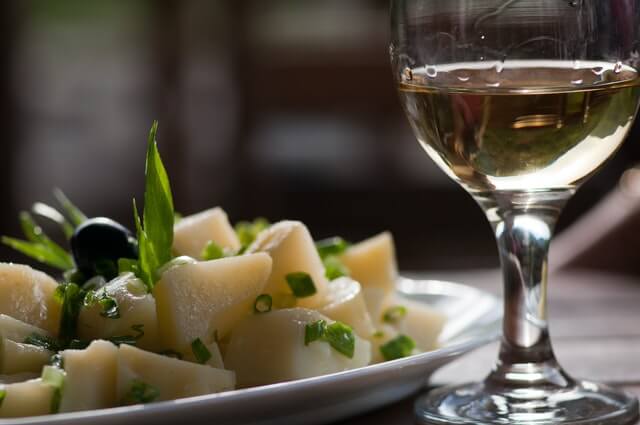Riesling is an aromatic white wine known for producing a wide array of wine styles, from bone dry to very sweet. Native to Germany, this white wine varietal is now present in many cool and warm climate regions around the world, where it is often praised as a favourite for many wine enthusiasts. In this article, we will quickly review the history of this wine, characteristics common to this varietal and core wine regions responsible for the production of this noble white wine.
The History of Riesling Wine
Native to the Rhine River Valley of Germany, the origins of this wine date back to the 1400s. Like many of the world’s great vines, for the first 200 years of its evolution, Riesling vineyards were largely tended by monks for the benefit of nobility.
By the late 1600s through to the late 1700s, German nobility had recognized Riesling as a superior variety, and many other varietals were jettisoned and replaced by Riesling. This set into place a glorious century for Riesling in Germany, during which time the best German Rieslings were priced on par with Champagne and the best red wines of Bordeaux and Burgundy.
The 1900s were not as good for German Riesling vineyards, as many were destroyed through World Wars I and II. Upon replanting, Riesling vines were often replaced by lesser varietals better at producing quantity rather than quality wine.
It wasn’t until the late 1900s when Riesling regained its status as Germany’s #1 varietal in terms of volume. Coincidentally, Riesling travelled around the world and is now found in many of the world’s finest cool-climate appellations.
Which Wine Regions are Known for Riesling?
The Riesling vine thrives in cool climate growing zones (particularly in the slate soils of the Mosel) but also in some warmer climate appellations with various soils. While seemingly contradictory, it is Riesling’s high acidity, retained even as the grape matures on the vine, that allows it to thrive in warmer climates. These conditions are found in multiple wine regions including:
- Germany – As mentioned above, Riesling is principally grown along the Rhine river, but is also present in all of the country’s grape regions. A third of Germany’s Riesling is produced in the Mosel Valley where the result is a delicate, light, crisp wine. However, other German wine regions such as Nahe, Pfalz and Rheingau are noted for producing fuller-bodied Riesling with structural acidity.
- France (Alsace only) – Located southwest of Germany’s border, the Alsace region in France adopted the growth of this white grape varietal in the 1600s. While the Alsace version of Riesling has a higher alcohol content due to a warmer climate, it shares many similarities with German Rieslings such as its high acidity and steely minerality. Side note: Alsace is the only wine region in France that allows Riesling as part of its appellation classification.
- Australia – In the 1800s, Riesling vines were brought to Australia from the Rheingau region of Germany. While the climate is warmer and drier than other wine regions that produce Riesling, Australian winemakers have been successful in maintaining its iconic high acidity. The Australian version of Riesling is noted for its lime and lemon flavours, as well as notes of orange blossom.
- United States – In the late nineteenth century, German immigrants brought their winemaking traditions to the United States. It was no surprise that the introduction of Riesling to the United States was part of their influence. Today, significant quantities of this grape are grown in Washington. the Finger Lakes region of New York and in the cooler wine regions of California.
- Canada – In the latter half of the twentieth century, a few prescient Canadian winemakers had the foresight to bring Mosel clones from Germany for transplant into select sites such as the Beamsville Bench, in Niagara, Ontario. Niagara’s cool climate viticultural zones were well suited to Riesling. Today, Riesling remains one of the most important varietals in the country.
Tasting Profile: What You Can Expect From this White Wine
This aromatic white wine offers fruity notes ranging from citrusy hints of lemon and lime to orchard fruits such as apple, apricot, pear, and nectarine. Expressive floral notes are often found in younger Riesling wines with many wine enthusiasts noting hints of jasmine, honey and citrus blossom.
Mineral notes of steel, slate or chalk are also common. Even more intriguing, and less commonly found in other wines, notes of beeswax and a striking note of petrol (which become more evident as the wine ages).
As noted earlier, early Rieslings tended to be on the sweeter side. However, modern winemaking (encouraged by a shift in consumer tastes from sweet to dry) has led to the development of a plethora of dry to bone dry examples of Riesling. Dry Riesling is now commonly produced in Germany and across the rest of the wine world.
How to Pair Riesling with Food?
Given Riesling’s wide band of styles, from bone dry to lusciously sweet, Riesling can pair up with all manner of food.
A crisp, lighter, dry to off-dry Riesling will pair well with proteins such as chicken, pork and duck as well as seafood and mild cheese. More robust Rieslings with higher alcohol and more body can take on this, plus heartier proteins and cheeses. More luscious, sweeter styles of Riesling are particularly well suited for Asian inspired, spicier foods and even dessert.
A delicious match on all accounts.

